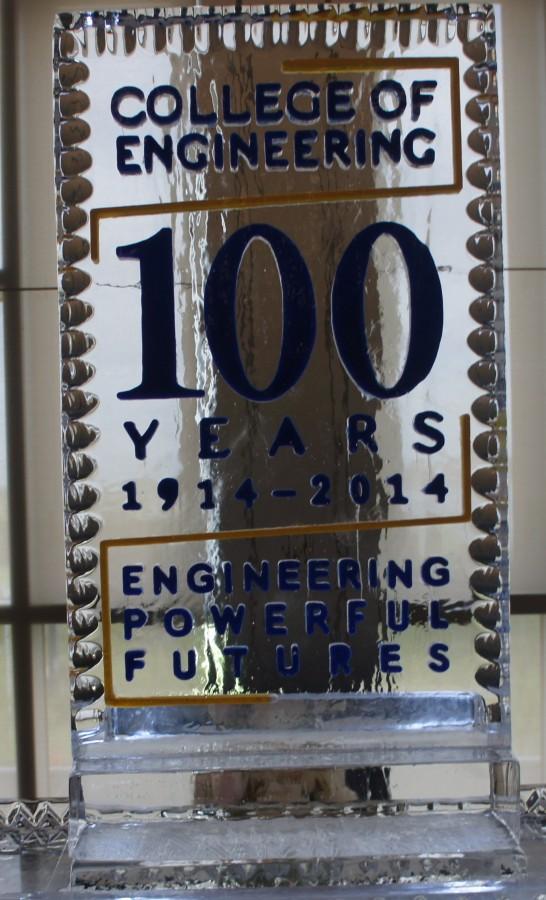College of Engineering celebrates centennial
Honor for 100 years of innovation
June 26, 2014
The centennial anniversary of the College of Engineering was a celebration of the past 100 years. The centennial was also an optimistic look at the next 100 years. The college that started with two professors and 28 students has grown over the century to 100 professors and 2,800 students.
The college is also home to its 100-year-old co-op program. Each speaker reflected this theme of the past, present and future as they described the roots of the college. Emphasizing the success of its students and how to carry on to the future.
The Associate Vice President and Chief Communication Officer Eileen Korey hosted the event. The celebration was not only for the 100 years of hard work. It was also an honoring of an early graduate of UA’s College of Engineering, Minnie Pritchard.
Pritchard was the first and only female student of the civil engineering class of 1955. She was also the first student to graduate with distinction from the college and went on to work at Goodyear Aerospace. In 1964, Minnie worked at her alma mater as a part-time teacher until becoming a professor in 1971.
Seeing how the university has changed Pritchard remarked, “It’s grown, it’s definitely grown, so has the engineering program…Very much so.” She gave her opinion about UA’s current engineering program.
“I think it’s top notch no matter what you do. I think you can go on from here to anything you want,” Pritchard said. She also explained how she felt about being a female engineer in the 1950s.
“When I worked at aerospace, some German engineers they brought over, they thought I was exceptional because I was a woman,” Prichard said.
The Dean of the College of Engineering George K. Haritos talked about responding to the needs of industry as a priority. Not forgetting to note for the college to stay vibrant and relevant. He stated the overriding priority is to produce job-ready graduates. It all ties with the second part of their equation for success is to take individuals from different backgrounds, interests and expertise and pull their talents together.
“The College of Engineering at the University of Akron has been successful and will continue to be so for two reasons: one, we know why we are here. Two, we all work together,” Haritos said.
Mike Sherman, Sr. Vice President took the podium next speaking about the co-op program. This is a program that combines classwork with real-world work experience, connecting students with job opportunities. Sherman called it the award-winning model, which “clearly engineers powerful futures.”
He discussed the education of UA degrees and student experiences as giving the ability to communicate, think, anticipate, innovate and be entrepreneurial. Sherman explained that this program educated students outside the classroom through work experience and this would achieve UA’s objective of 80 percent job placement.
“And now, companies that hire our engineering students are hiring our students in accounting, marketing, finance, communications, English, and math,” Sherman said.
Sherman believes future students will look back at the College of Engineering for transforming UA as a whole.
President Luis Proenza recognized the audience for their support for the college of engineering and his pride in the students.
“One thing that I brag about most often is the success of these students here. Our students have won more awards than any other single university and more awards than all other Ohio universities combined,” Proenza said.
Proenza concluded with relaying the accomplished positions and diverse education of the guest speaker of the evening, Deborah L. Wince-Smith, President and CEO of the Council on Competitiveness.
Wince-Smith’s time on the podium was diverse in the topics she spoke about as she captured the spirit of the occasion, infusing many messages spanning ancient history to modern innovation. She was very versatile in communicating and linking scientific prospects to global economics and politics.
Many things she relayed interrelated engineering, science, and the global economy as well as the changing global landscape for competitiveness brought on by technological and scientific advances.
“Science makes shifts that are reshaping our economic competitive and technology competitiveness,” Wince-Smith said.
She made it clear that they’re a concentrated effort on innovation and economic activity should continue. Wince-Smith explained large-scale engineering problems such as cyber security and modern manufacturing.
Touching on the need for using engineering and innovation to change the way people lived and worked in the balance of power. She called upon her knowledge of paleontology to illustrate the power of innovation.
She concluded her remarks with explaining what really matters are the creativity and imagination in an environment to learn and experience things.
“We need artists who think like engineers and engineers who think like artists. We need a cauldron of creativity,” Wince-Smith said.
The 100-year trek of the College of Engineering started as Buchtel College with Frederic E. Ayer as its first dean. Over the next century more programs and buildings were added to the college, expanding its curriculum and departments. Since its conception the college has responded to the needs of industry and evolved to fill new niches.
Deborah left the podium with a quote from LBJ, which further illustrated the night’s theme of innovation: “For this is what America is all about. It is the uncrossed desert and the unclimbed ridge. It is the star that is not reached and the harvest that is sleeping in the unplowed ground.”














